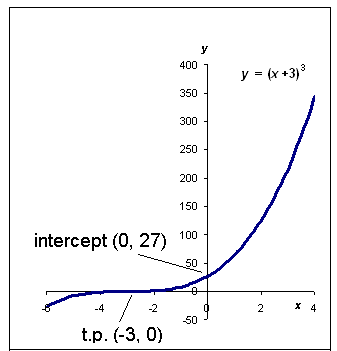1. Answer all parts (a) to (d). All parts carry equal marks.
Determine the following:
(4 marks)
2. Answer all parts (a) to (d). All parts carry equal marks.
Differentiate the following functions with respect to x, and simplify the result where possible:
(8 marks)
3. Answer all parts (a) to (c).
Consider the function y(x) = (x + 3)3.
(a) Differentiate this function (without multiplying out the brackets) and thence determine the co-ordinates (x,y) of the stationary point(s).
(4 marks)
(b) Do the stationary point(s) correspond to local maxima, minima, or point(s) of inflection?
(4 Marks)
(c) Hence sketch this function between x = -5 and x = +1.
(4 Marks)
1)
2)
a) Product Rule: (7x + 5).(-5) + (10 - 5x).7 = 45 - 70x
b) Product Rule: 4x21(1/x) + (ln x. 84x20) = 4x20(1 + 21ln x)
c) Quotient Rule: ![]() =
= ![]()
d) Funct. of a Funct.: 5cos(x6 - 2x7)![]() (6x5 - 14x6) = 5(6x5 - 14x6)cos(x6 - 2x7)
(6x5 - 14x6) = 5(6x5 - 14x6)cos(x6 - 2x7)
3) a)
Using Func. of Func. Rule, dy/dx = 3(x + 3)2.(1) = 3(x + 3)2
At the t.p., dy/dx = 0, so 3(x + 3)2 = 0, so there's only 1 soln at x = -3.
Feeding x = -3 back into the original eqn, we get that the t.p is at: (-3, 0).
b) d2y/dx2 = 6(x + 3), and at x = -3 this has a value of 0. So the t.p. is a point of inflection!
Checking the gradient either side of the t.p.: at x = -4, dy/dx = +3, so it's increasing.
At x = -2, dy/dx = +3, so it's increasing too.
c) When x is very large and +ve, y is v. large and +ve. When x is large and -ve, y is large and -ve. When x = -3, y = 0, and this is the t.p. When x = 0, the intercept y = 27. Students must label axes, t.p. and intercept on graph.
